- europages
- >
- COMPANIES - SUPPLIERS - SERVICE PROVIDERS
- >
- linear transducers
Results for
Linear transducers - Import export
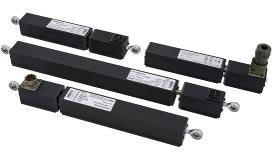
ELAP AUTOMAZIONE INDUSTRIALE
Italy
Accurate, strong, easy to mount, and weatherproof, the transducers series PD and PE are the ideal solution when you need to measure thickness or control linear displacement on any kinf of industrial machine. High reading resolution (up to 0.005 mm) Easy mounting method High protection against environmental agents (IP65) Strokes: 60 ÷ 990 mm
Request for a quote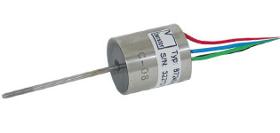
BURSTER PRÄZISIONSMESSTECHNIK GMBH & CO KG
Germany
Displacement and all mechanical values which can be converted to displacements (e.g. compressive and tensile force, strain, torque and vibration) may be measured by this DC/DC displacement sensor. Typical application areas are the measurement of displacement and strain on machines, servo systems, vehicles, on test plants, in civil engineering and tunnel construction. An integrated maintenance-free electronic and a high-level DC output signal provide an easy handling without any problems. Displacement sensors of series 87240 convert a displacement into an analog electrical signal. They consist of a differential transformer with moveable core, an oscillator and a demodulator. These components are integrated and encapsulated in a cylindrical housing made of stainless steel. The sensors are energized by DC voltage, which is converted to AC by the oscillator and brought to the primary coil of differential transformer.
Request for a quote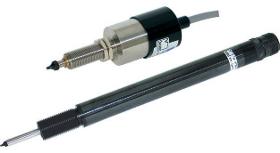
BURSTER PRÄZISIONSMESSTECHNIK GMBH & CO KG
Germany
Linear displacements and mechanical values which can be converted to displacements (e.g. compressive and tensile force, strain, torque and vibration) may be measured by these DC/DC displacement sensors. The probe tip of these sensors is pushed onto the measuring object by a spring. This makes it possible to use these sensors were a mechanical modification of the measurement object (mounting hole) is not allowed or difficult. Output voltage as function of the displacement with the impedance as parameter. Sensors of series 87350 generally consist of an oscillator, a demodulator and a transformer with moveable core. They are energized by DC voltage. The oscillator uses this DC voltage to generate the carrier frequency, which is needed for the operation of the sensor. Dependent on the position of the core, which is made of ferromagnetic material, voltages are induced by the two secondary coils of the transformer.
Request for a quote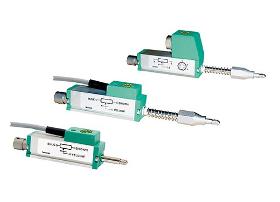
BURSTER PRÄZISIONSMESSTECHNIK GMBH & CO KG
Germany
These displacement sensors are potentiometric displacement sensors used for direct measurement, testing and monitoring of mechanical displacements. The spring-loaded control rod eliminates the need of coupling with the measurement object. A prerequisite for a very long life duration of the devices is a parallel alignment of the motion direction of the measurement object and the rod. Areas of application are: Displacement on: —Electromagnets —Hydraulic cylinders —Switches and buttons Measurements of: —Deformation —Bending —Press-fits —Feed strokes Due to the technology employed in potentiometric displacement sensors, they always operate with a sliding contact system. FEATURES: —Measurement ranges: 0 ... 10 mm to 0 ... 150 mm —Non-linearity up to 0.05 % F.S. —Resolution 0.01 mm —Follower roll on request —Optional with internal spring
Request for a quote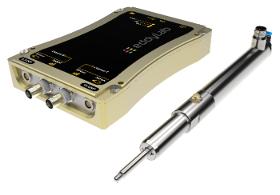
EDDYLAB GMBH
Germany
he greatest challenge in the use of inductive displacement transducers is the optimization of linearity. Usual linearity deviations are around 0.30 % of the measuring range of the sensors. Values that are significantly below this can hardly be realized. With the help of the LVDT digital controller from eddylab, to which either one or two sensors can be connected, the linearity deviation of inductive displacement transducers can be almost completely eliminated. KeyFeatures ■ Improves linearity up to 0.01%. ■ High resolution (16 bit) ■ High dynamic range ■ Digital output CAN, USB interface ■ Analog output ■ High noise immunity
Request for a quote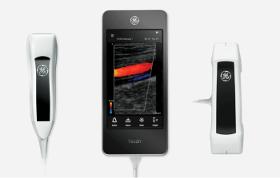
IMV IMAGING
United Kingdom
Vscan Air is a battery-operated general-purpose diagnostic ultrasound imaging system for use by qualified and trained veterinary professionals. Vscan Air consists of a dual-headed probe, which integrates both curved and linear array transducers. The Vscan Air probe comfortably fits in the palm of your hand and is almost as light as a smartphone. You can carry it in your pocket all day and take it wherever you go and the simplified user interface enables integration into training sessions and examinations suitable for both in practice and field environments.
Request for a quote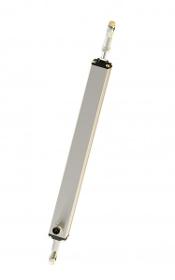
TWK-ELEKTRONIK GMBH
Germany
The linear transducer model PWA measures the absolute position of the plunger without contact or wear using an inductive resonator measuring system. This consists of an excitation coil which causes an oscillating resonance circuit (moving target) fastened to the plunger to oscillate. This in turn excites the receiver coils fixed in the housing, which are printed on a printed circuit board. The integrated electronics transform these signals (sin/cos) into a signal proportionate to the linear travel. The measuring system is insensitive to electrical and magnetic fields. 0(4) to 20 mA and 0 to 10 VDC are available as standard as analogue signal outputs. CANopen, IO link and SSI are in preparation. The sensor is fastened using at least two retaining clips HK-01 or using sliding blocks ST-01. The sensor can be equipped with ball joints at the front and rear. Alternatively, the sensor's plunger can be designed as a button.
Request for a quote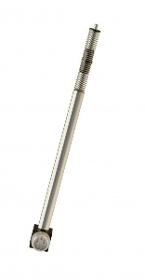
TWK-ELEKTRONIK GMBH
Germany
The linear transducers operate according to the differential throttle principle (inductive half-bridges). They consist of two coils which are impermeably cast into a Mu-metal cylinder, where they are protected from vibrations. On displacement through the hollow coil body, a Mu-metal plunger leads to a change in the induction direction in both coils. The linear transducers are designed for an oscillator frequency of 10 kHz. The supply and signal processing are carried out by external modules.
Request for a quote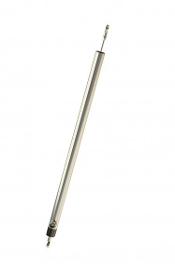
TWK-ELEKTRONIK GMBH
Germany
The displacement transducers work according to the principle of the differential choke (inductive half bridges). They consist of two coils which are encapsulated in a Mu metal cylinder in a sealed and vibration-proof manner. A Mu-metal plunger causes an opposite induction change in the two coils when displaced by the hollow coil body. The displacement transducers are designed for an oscillator frequency of 10 kHz. Power supply and signal conditioning are provided by external module modules.
Request for a quote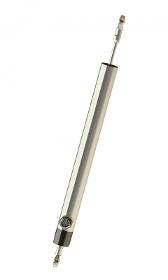
TWK-ELEKTRONIK GMBH
Germany
The displacement transducers work according to the principle of the differential choke (inductive half bridges). They consist of two coils which are encapsulated in a Mu metal cylinder in a sealed and vibration-proof manner. A Mu-metal plunger causes an opposite induction change in the two coils when displaced by the hollow coil body. The displacement transducers are designed for an oscillator frequency of 10 kHz. Power supply and signal conditioning are provided by external module modules.
Request for a quote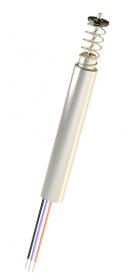
TWK-ELEKTRONIK GMBH
Germany
The displacement transducers operate according to the principle of the differential choke, i.e. an inductive half bridge. They consist of two coils which are encapsulated in a stainless steel cylinder ensuring positive protection against vibration, shock, humidity, oil and corrosive matter. A mu-metal plunger core causes opposing changes of inductance when it is displaced through the centre of the coils. The displacement transducers are designed for a carrier frequency of 10 kHz. Other frequencies can be used but may involve changes of output values.
Request for a quote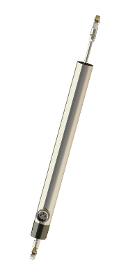
TWK-ELEKTRONIK GMBH
Germany
The displacement transducers work according to the principle of the differential choke (inductive half bridges). They consist of two coils which are encapsulated in a Mu metal cylinder in a sealed and vibration-proof manner. A Mu-metal plunger causes an opposite induction change in the two coils when displaced by the hollow coil body. The displacement transducers are designed for an oscillator frequency of 10 kHz. Power supply and signal conditioning are provided by external module modules.
Request for a quote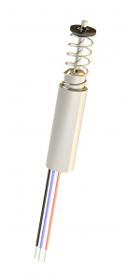
TWK-ELEKTRONIK GMBH
Germany
The displacement transducers operate according to the principle of the differential choke, i.e. an inductive half bridge. They consist of two coils which are encapsulated in a stainless steel cylinder ensuring positive protection against vibration, shock, humidity, oil and corrosive matter. A mu-metal plunger core causes opposing changes of inductance when it is displaced through the centre of the coils. The displacement transducers are designed for a carrier frequency of 10 kHz. Other frequencies can be used but may involve changes of output values.
Request for a quote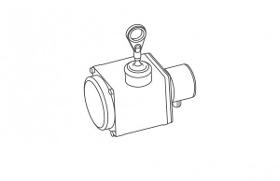
TWK-ELEKTRONIK GMBH
Germany
Please note that this product is an accessory. In the "Products" section you will find the corresponding encoders that you can order for your selected article.The linear movement of a flexible steel cable, which can have a length of up to 5 m, is converted into an rotary movement with the aid of a measuring drum. The measuring drum is connected to the shaft of an encoder. In this way a change in displacement of the measuring cable causes the shaft of the encoder to rotate by a directly proportional amount which can be recorded. The restoring force of the spring drive holds the measuring cable tight at all times and prevents any sagging which would otherwise induce an error. The cable is wound up precisely and reproducibly wrap for wrap in the helical groove of the drum. The nozzle, through which the cable enters the drum, is protected with a brush and a bellow to prevent water or dust entering the drum. Two roller units at the cable entry allow for up to 20° <) deflection of the cable.
Request for a quote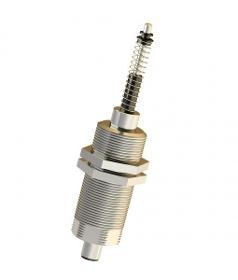
TWK-ELEKTRONIK GMBH
Germany
The displacement transducers work according to the principle of the differential choke (inductive half bridges). They consist of two coils which are encapsulated in a Mu metal cylinder in a sealed and vibration-proof manner. A Mu-metal plunger causes an opposite induction change in the two coils when displaced by the hollow coil body. The displacement transducers are designed for an oscillator frequency of 10 kHz. Power supply and signal conditioning are provided by external module modules.
Request for a quote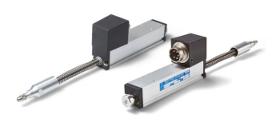
MEGATRON ELEKTRONIK GMBH & CO. KG
Germany
The displacement sensors of series SPR18 are used in industrial applications, which require a compact linear transducer with spring-suspended probe tip, long lifespan, high accuracy, rear and front guided push rod with measuring length from 25 to 100 mm. The compact and robust linear potentiometers of the series SPR18 are designed for industrial applications. The housing profile made of anodized aluminium corresponds to the usual industrial dimension with 18x18 mm. The transducer has a stainless steel ball in the probe tip, for example for scanning profiles or for monitoring distances. In the displacement sensor series SPR18, the mechanical detection of linear movement is done by a rear and front guided push rod.
Request for a quote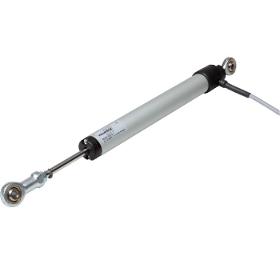
MEGATRON ELEKTRONIK GMBH & CO. KG
Germany
The displacement sensors of series RC20 are used in applications with harsh environmental conditions, which require a robust linear transducer with long life span, high accuracy and guided push rod with measuring lengths from 10 to 300 mm. The linear potentiometers of the series RC20 are designed for applications with harsh environmental conditions. For mechanical coupling, the displacement sensors are available in three mounting versions: mounting brackets, ball joints or flange. The variant with ball joints compensates movements transversely to the push rod, so that non-linear movements can also be coupled simply and without stress. The mechanical detection of linear movement is done by a front guided push rod
Request for a quoteDo you sell or make similar products?
Sign up to europages and have your products listed
Results for
Linear transducers - Import exportNumber of results
18 ProductsCountries
Company type